Bicycles and Beer
For whatever reason, most of the cyclists I know have an appreciation for good beer. Granted, there’s a fair amount of PBR and Schlitz consumed among this demographic, but I consider those beers close to water anyway and hydration is important. With that in mind, this blog entry is mostly about beer and not really about bicycles.
At the end of every summer my homebrewing capacity is converted over to wine and cidermaking to coincide with the grape and apple harvest season. The wine ferments to completion and is ready to bottle by the beginning of December, which is when I start homebrewing in earnest, building up beer to have on tap at home, bring to social events or give away. This past weekend marked the first batch of homebrew that I’ve made since early summer. Beer tastes best when it’s fermented in ambient temperatures of 60 degrees or less, so I don’t brew in the heat of the summer, and by this time of year my stock is completely depleted. As you can imagine, it’s exciting for me to start brewing again.
My first batch of beer this year is an American Pale Ale of my own design. I try to keep this particular beer on tap most of the time. This is a relatively low alcohol, easy to drink beer classified as a ‘session’ beer. The recipe is simple, it’s something I’ve made dozens of times and it allows me to get my brewing chops back without needing to pay attention to more complex brewing procedures.
I brew beer in 10 gallon batches using an all-grain process. I start with whole grain malted barley and crush it using a hand-cranked mill:
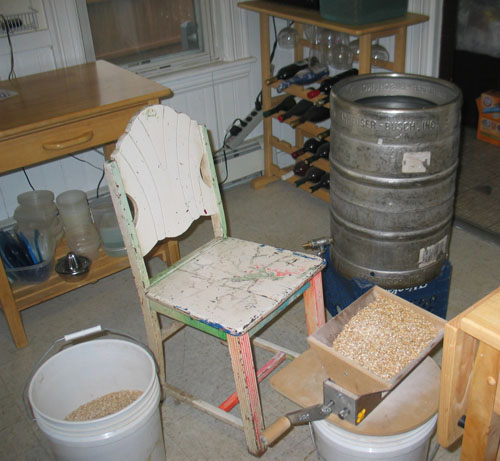
I had to tweak the grain mill roller’s spacing to get a proper crush; it probably won’t need to be reset for the rest of the brewing season now. I hand-cranked the grain through the mill twice, all 20 pounds of it, into an old Budweiser keg that the grain is steeped in. This is a fitting fate for a Budweiser product — to make beer that is far more flavorful and interesting. Here’s the crushed grain in the old keg:
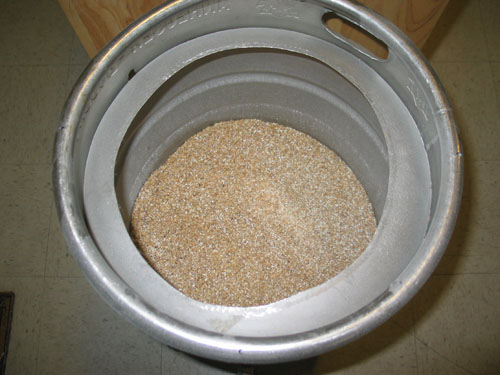
The next step in this process is to add water that’s been heated to 175 degrees. When this is mixed with the grain, the whole mess cools to about 154 degrees. The process of steeping grain in hot water is called ‘mashing’, and the steeping grain is called ‘mash’. The mash at this specific temperature activates certain enzymes that are in the barley seeds. These enzymes cut apart complex carbohydrates like starch, converting them to simpler sugars that yeast can ferment. Yeast can’t digest complex carbohydrates, so we have to use the enzymes in the barley seeds to start the digestion process.
It takes about 30 minutes for most of the carbohydrates in the barley to be converted. I let this sit for an hour to maximize the conversion, stirred every 20 minutes to redistribute the heat as the mash cools against the outside of the keg:

After an hour of steeping, I drain the barley ‘tea’ (technically called ‘wort’) through a strainer in the bottom of the mash bucket and move it to another converted Budweiser keg to be boiled. I’ll add and then drain more hot water, in batches, to the mash bucket in order to rinse the grain and extract as much sugar and flavor as possible. A total of about 11 gallons of wort are collected from the mash bucket and moved into the boiling bucket.
I use a propane burner in my small back yard to boil the wort for an hour. Hops are added three times during this stage: once at the beginning of the boil, to bitter the beer, once about 20 minutes before the end of the boil, to add hop flavor, and once close to the end of the boil to add aroma.
After the wort has boiled for an hour, it’s cooled using water run through a copper coil submerged in the wort:
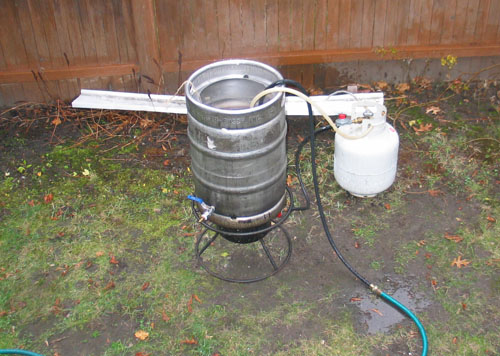
Once the wort has cooled to about 60-65 degrees, it’s drained into two glass fermentation containers (called ‘carboys’) and yeast is added:
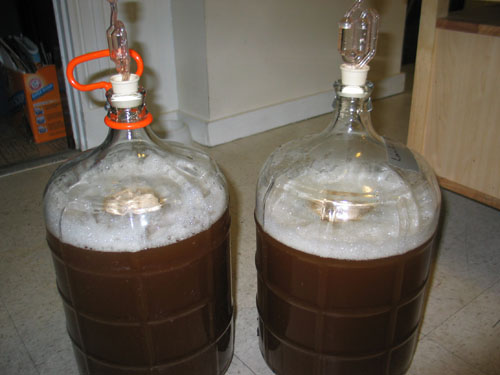
After the yeast is added to the wort, the wort can now be properly called beer, although at first the beer won’t have any significant amount of alcohol in it. The yeast will ferment this beer for a few weeks, converting the sugars to carbon dioxide and alcohol. After the beer is finished fermenting, I’ll add more hops to it to enhance the aroma; this step is called ‘dry hopping’ and it’s only done when creating a beer with a prominent hop profile.
I also bottled a barleywine — a very big beer, lots of rich and complex flavor and high in alcohol — that I brewed with a friend last spring. Here it is being drained into the bottling bucket; it has a rich, dark brown color:
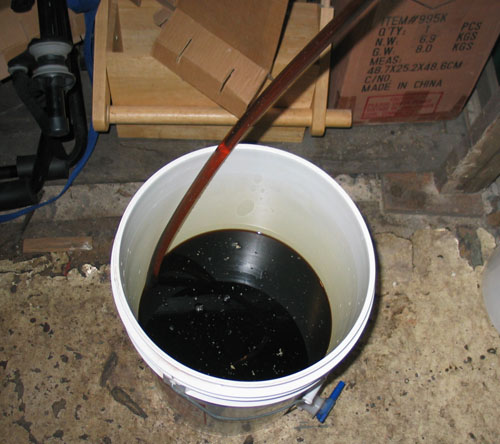
And here are the bottles in the process of being delabeled and cleaned:
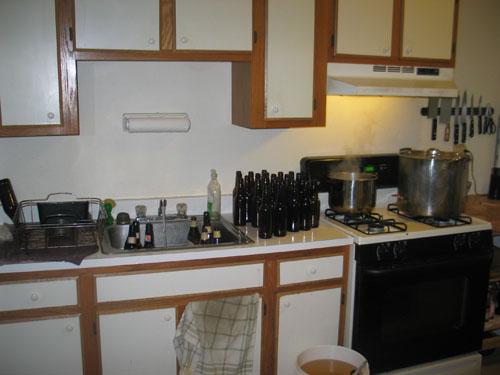
I add a little bit more sugar to the beer, put it in bottles and use a hand-powered capping machine to cap the bottles. The small amount of added sugar will be cause the yeast to produce carbon dioxide inside the bottle, carbonating the beer. It won’t be ready to drink for another month, and I’ll age most of this barleywine for several years. Contrary to what advertisers would have you believe, ‘fresh’ beer is only better when the beer is low in alcohol to begin with. Big, high alcohol beers, like wines, peak in flavor after 2-4 years or more.
This batch will probably be ready right around New Year’s.
————–
My next bicycle project is to take steel rod and tube stock and design braces for the seat tube of the Higgins frame bicycle I’ve been working on for a few months now. This is how I found the deceptively heavy steel stock after it was delivered and y.t. moved it into the apartment:

 Comments(1)
Comments(1)